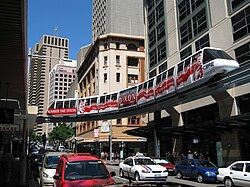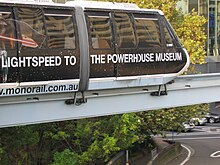Sydney Monorail
| Sydney Monorail | |||||||||||||||||||||||||||||||||||||||||||||||||||||
|---|---|---|---|---|---|---|---|---|---|---|---|---|---|---|---|---|---|---|---|---|---|---|---|---|---|---|---|---|---|---|---|---|---|---|---|---|---|---|---|---|---|---|---|---|---|---|---|---|---|---|---|---|---|
|
Monorail in Sydney City Center
| |||||||||||||||||||||||||||||||||||||||||||||||||||||
|
Overview map
| |||||||||||||||||||||||||||||||||||||||||||||||||||||
| Route length: | 3.5 km | ||||||||||||||||||||||||||||||||||||||||||||||||||||
| Gauge : | 940 mm | ||||||||||||||||||||||||||||||||||||||||||||||||||||
| Maximum slope : | 65 ‰ | ||||||||||||||||||||||||||||||||||||||||||||||||||||
| Minimum radius : | 20 m | ||||||||||||||||||||||||||||||||||||||||||||||||||||
| Top speed: | 33.0 km / h | ||||||||||||||||||||||||||||||||||||||||||||||||||||
| Operating points | |||||||||||||||||||||||||||||||||||||||||||||||||||||
|
|||||||||||||||||||||||||||||||||||||||||||||||||||||
The Sydney Monorail (originally called TNT Harbourlink , later Metro Monorail ) was a monorail in the Australian city of Sydney , which operated from July 21, 1988 to June 30, 2013. It was dismantled in favor of the construction of the Sydney International Convention, Exhibition and Entertainment Precinct .
history
The idea arose at the beginning of the 80s of the last century when it came to revitalizing Darling Harbor - at that time an industrial wasteland in the west of the city center. The project was controversial, both in terms of its impact on the cityscape and in terms of its effectiveness as a means of public transport . The aim was to train the occasion of the celebrations of the 200th anniversary of the occupation of Australia by Britain to take on 26 January 1988 in operation. The date could not be kept and the railway did not start operating until July 21, 1988.
There were ongoing protests from residents, over whose houses the monorail sometimes ran directly. Another point of criticism was that the monorail is not integrated into the rest of the city's local transport system. In March 2012 it was finally announced that the monorail would be closed and the route would be dismantled in the following years. The last day of operation was June 30, 2013.
route

The train ran in the city center and connected the Central Business District with Darling Harbor and Chinatown on a 3.5 km long ring line . There were eight stations . A train took twelve minutes to complete a circuit. The route was only driven counter-clockwise.
The roadway consisted of a steel girder with a width of 940 mm, which was mounted at a height of at least 5.5 m on supports at a distance of 20 to 40 m. The curve radius of the route was extremely small at 20 m. The maximum gradient was 44 ‰ on the ascent and 65 ‰ on the descent. The only “ switches ” of the system were on the way to and in the depot between the Convention and Paddy's Markets stations . These were sections of the route that were shifted at an angle of 90 degrees to the direction of travel, i.e. transfer platforms . A train was placed on it for the process if it was to enter the depot or to be parked.
Trains
It was a Von Roll III monorail . Because of the tight curve radii, a railcar consisted of seven very short articulated segments, was 32.12 m long, 2.06 m wide, 2.06 m high and weighed 35 tons. The segments were designed as individual cabins without connecting doors. A train could carry up to 170 people (56 seats). The difference between sitting and standing can be explained by the fact that the train was originally intended as a means of public transport and only covered short distances. The vehicles rolled on rubber wheels and drove fully automatically in normal operation, but could also be controlled manually. At the end of the train there was a simplified driver's cab that only allowed emergency or shunting trips .
Each train was powered by six 37 kW motors. The energy was fed in via a busbar attached to the side of the driveway. The operating voltage was 525 V AC . In the event of a power failure, an emergency generator was available so that the trains could run to the next station.
The maximum speed of the trains was 33 km / h. There were six trains, but usually only two or three were used at the same time. Theoretically, around 5000 people could have been transported per hour.
business
The operation was carried out by Veolia Transportation on behalf of Metro Transport Sydney , which also operates the Metro Light Rail (a light rail ) in Sydney. It was possible to change at the Halt Convention .
The system was designed so that it could be controlled by a single dispatcher. This sat in the depot.
Importance for traffic
The train was only used by half as many passengers as estimated in its planning. This was mainly due to the fact that it was not exactly linked to other modes of transport, the circular route, which only allowed passengers who want to reach a specific destination to use short distances and the fact that the network cards for Sydney's public transport were not valid there: A separate ticket was required. The railway was therefore primarily a tourist attraction and was also of practically no importance for local transport in Sydney. The originally longer travel times from Monday to Thursday have been reduced to 7:00 a.m. to 10:00 p.m., and to 8:00 a.m. to 10:00 p.m. on the other days. Around 30,000 passengers were transported every day.
literature
- Shane O'Neil: Metro Monorail . In: Railway Digest (March 2009), p. 32f.
Web links
Individual evidence
- ↑ Stations of the Sydney Monorail ( Memento of the original from April 4, 2011 in the Internet Archive ) Info: The archive link was inserted automatically and has not yet been checked. Please check the original and archive link according to the instructions and then remove this notice.
- ↑ morgenpost.de - Sydney loses one of its tourist attractions March 24, 2012



